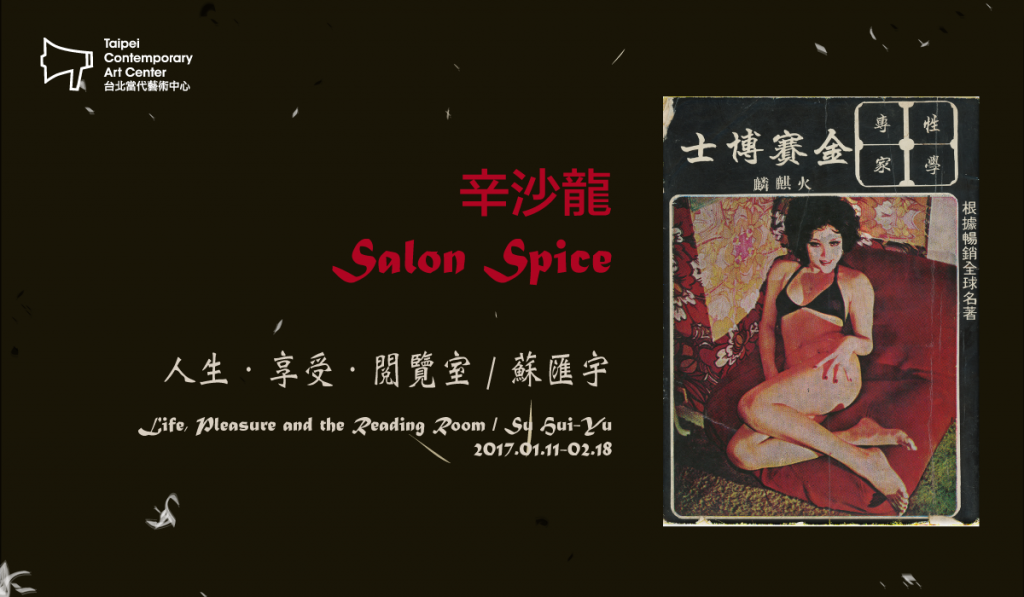For English, please scroll down.
時間:2017.01.11-02.18
地點:台北當代藝術中心,台北市保安街49巷11號(捷運大橋頭站)
活動-蘇匯宇的午夜閱讀場:2017.02.17(五),9pm
本集主角將是俗稱「小本」的這種色情刊物,是戒嚴時期以及家庭錄放影機(VHS)普及前的1980年代,台灣異性戀男性最主要的慾望出口,供應青少年與普羅階級便利且低廉的情色產品。藝術家蘇匯宇希望能透過設立一座小型閱覽室,將這類逐漸失傳的老派黃色書刊予以保存並提供閱覽,為現在與過去搭起一座時空橋樑,透過閱讀這些失效的甚至顯得可笑但又風韻猶存的煽情文字以及姿勢過於矯飾的性愛圖片,人們得以將自己帶往一個異度時空。
首次登場的《人生・享受・閱覽室》將以簡易的分類如「言情」、「硬蕊」、「寫真」、「教育」、「科學」與其他等項目向觀眾展示上百本藏書,並在展示期間中,由藝術家與參與者在閱覽的過程中進行更細緻的考掘,從其中流露的意識型態與科學知識之考察中,進一步將這些文本提煉成為更有趣的觀念素材。那些老舊而失效的文本將讓人們感到此時此刻的一切亦不再那麼令人深信不疑,也或許人們可能因此會想起自己身體的某些面向曾經(或正在)被禁制或虛構,正待被重新探索與重新啟動。同時現場亦將展示兩件錄像作品,分別是新作《人生的享受》與《自瀆有礙身心之說不可信(金賽博士)》(2017影展版)。
關於藝術家
影像、媒體、史料與日常生活交織後的複雜現象吸引著蘇匯宇,過去他以錄像探討大眾影視媒體對人們觀看的影響,以及人們對媒體的思想與慾望的投射。電視與電影的暴力美學、失眠夜的恍惚情境、虛實交錯的幻境景象、電影文化對於女性身體影射或明示的情色與性暗示等,其各式創作主題皆取材於自身被媒體環繞的相關經驗,從電影、電視文化、廣告、國家機器、恐怖主義、自我與他者、身體、慾望投射乃至幻覺與真實等議題都是他的關注項目。近期蘇匯宇開始著迷於古籍的閱讀經驗,透過重讀、重敘與重新組裝過往時代的書籍,獲取對於身體、存在與歷史等課題的重新認識。作品曾展出於台北市立美術館、國立台灣美術館、台北當代藝術館、關渡美術館、高雄市立美術館、加州聖荷西美術館、康乃爾大學的強森美術館以及上海當代藝術博物館等重要機構,2013年錄像作品《稍待片刻》獲邀參加「盧森堡電影節」,於 Casino Luxemburg當代藝術中心播映。曾獲ACC「國巨科技藝術獎」獎助,於2009年前往紐約駐村。
關於辛沙龍
TCAC在2017年所全新推出的《辛沙龍》系列將首度嘗試透過展演情境創造和焦點議題的發展來輪廓未來政治的形貌。全年度的活動節目將從「身體政治」的再出發來思考各種切身於社會關係組織、政治權力的議題,從性和死亡等兩大軸線來探索不同文化如何理解身體作為當代社會中作為何種政治媒介、意識形態、文化符碼和結構規訓的載體。從而觀看身體在文化歷史上、在藝術文本中如何展現、交織、再現個體和集體的慾望和運作;在政治經濟上,又如何可能被歸納到各種被英雄化、神聖化、殘疾化、工具化、機械化、畸形化、妖魔化等狀態。這些身體政治的問題意識將引導我們重新關注並辨識自身現代化的真正起始點,並思索所處當代社會身體的病徵。相關的子題或將擴延至情慾、性別、身份政治、酷兒研究、女性主義、暴力、痛苦、死亡、後網路、賽伯客等,以長達兩年的時間來梳理關於身體實踐之徑。
辛沙龍系列關注如何在21世紀創造一種新型態的藝術沙龍聚會發表以滋養公共領域的知識生產與藝術實踐,讓藝術家與各界人士得以在一種共學、協作的過程裡展開長期對話性的研究討論、展示實驗、創意激盪並衍伸更多展覽形式以外的藝術言說方式來和觀眾/參與者進行溝通,演練奇想空間場域。這同時將作為TCAC開發公共領域擴延思索以及藝術實驗場的手段,刺激在地藝術社群擴延議題思想和跨文化交流的範疇,以此投射對藝術中心在空間敘事、身份功能、社群關係上的開放想像。
Time: 2017.01.11-02.18
Venue: Taipei Contemporary Art Center, No. 11, Lane 49, Baoan Street, Taipei (MRT Station: Daqiaotao)
Event Su Hui-Yu’s Midnight Reading: 2016.02.17 (Fri), 9pm
This episode brought by artist Su Hui-Yu will focus on the so-called “small books” (xiaoben), a type of pornographic materials that had been the major gratifier for the erotic desires of Taiwanese heterosexual males until the video home system (VHS) had achieved a supreme dominance in the 1980s under the martial law. “Small books” used to be cheap and easily available for juveniles and the lower-middle classes. To preserve the collective memories, the artist sets up a small reading room where this dying-out type of vintage pornography can be available for public reading. The reading room will not only provide a unique atmosphere congenial for public participation without intruding readers’ privacy, but also build a bridge reconnecting people with the past.
Life, Pleasure, and the Reading Room will present Su’s collection on these vintage pornography books for the first time. They will be displayed in the artistic index system, such as “erotic”, “hardcore,” “realism,” “educational,” “science” and etc. During the display period, the artist will also invite participants for a close reading on the ideologies and sciences enclosed in the collection to transform the textual contents into interesting conceptual materials together. Perhaps these old invalid texts will create new doubts for us to relate to our present, and we may therefore realize how our bodies have been (or still are) restricted or fictionalized, waiting for new exploration and activation. Two of his video works will be also on view: The Pleasure of Life and Thou Shalt Not Self-Pollute (Dr. Kinsey).
About the Artist
Su Hui-yu is fascinated by connections among images, media, history, and daily life. In his videos, he explores both mass media’s impact on viewers, and the projection of viewers’ thoughts and desires onto media. Themes in his work include the aestheticization of violence, trance-like sleepless states, the interplay between reality and fantasy, and eroticization of the female body in films. He draws from his experiences with various media, cultures, and the body, as well as national mechanisms, terrorism, and even the self versus the other. Recently, Su’s interest in old books, from which he appropriated and revised text for his work, has led him to a new understanding of physicality, existence and history. His work has been exhibited at the Taipei Fine Arts Museum, Kuandu Museum of Fine Arts, Hung-Gah Museum, National Taiwan Museum of Fine Arts, MOCA Taipei, Kaohsiung Museum of Fine Arts, San Jose Museum of Art, Herbert F. Johnson Museum of Art at Cornell University, and Shanghai’s Power Station of Art. In 2013, Su’s The Upcoming Show was screened at the Luxembourg City Film Festival. His solo exhibitions, The Fabled Shoots in 2007 and Stilnox Home Video in 2010, were nominated for the Taishin Arts Award. In addition, Su was awarded the Asian Cultural Council Fellowship Award and participated in a residency program in New York City in 2009.
About the Salon Spice
In 2017 TCAC is launching a new program series as an attempt to contour future politics by creating a tangible open space for connecting experimental displays and thematic discussions: the Salon Spice. Taking a departure from “body politics”, the Salon Spice will contemplate issues related to social organization and the distribution of political power from two main subjects “sex” and “death.” We will explore how bodies are at the center of this topic, subject to political agency, ideology, cultural symbol, structure and discipline across different cultures. Through a cultural and historical lens, we shall examine how bodies are presented and connected by their representation among individual and collective desires and manipulations in art. Politically and economically speaking, we will investigate how bodies are constantly labeled and classified as heroes, holy figures, witches, or the disfigured. The abnormal, alienated, instrumentalized or body-as-machine figures shall also be examined. These problematic topics will lead us to rethink and identify the real starting point for our very own modernization progress, and link with the symptoms of the contemporary social bodies. Related topics may also extend to eros, gender, identity politics, queer studies, feminism, violence, pain, death, post-internet, cyborg, etc.
The Salon Spice series suggests how to create a 21st century art salon that meets diverse variations of contemporary knowledge production, artistic practice and development of public sphere. It aims to create a co-learning collaborative environment and process for artists and other professionals by building conversations and navigating through research, display experiments, brainstorming, and other artistic communication beyond the form of exhibition-making, and together, exercising the space with fantasy and intervention. This could be considered as one of the strategies for TCAC to expand the public realm and art experimentation, providing a progressive platform for the local art community to explore ideas and intercultural exchanges that can be a part of the public imagination for the art center’s space narration, institutional identity, function and community.

